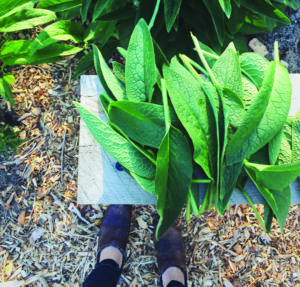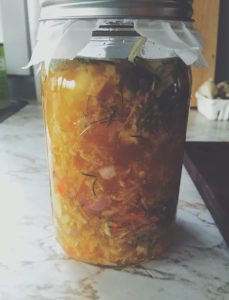
EASTHAM — My garden is popping with bright green life as perennials wake: lemon balm, mint, oregano, chamomile, echinacea. The sight is soothing, and it brings to mind the ways these herbs are looked to for their health-giving properties. Indoors, preparations continue for expanding the garden: starting seeds and recording plans for where things will go and when to get them there.
All of this is medicine in the making. The events of 2020 have renewed inspiration for victory gardens, not only for growing food, but for health, and for peace of mind. We have an opportunity now to reconnect with nature and earth. We can nurture dormant seeds into life, or support our local farmers who do, creating food and remedies for the season and beyond. We can make art from it, paint or take pictures of it, and provide food and shelter for birds and pollinators. We can share it with friends, neighbors, and the community.
In planning a medicinal garden, consider the ingredients for fire cider — a tonic that combines fresh green herbs with tart and hot flavors from the garden, and is sweetened with local honey. Many take a shot or two daily, especially during flu and cold season. Others swear by it as a digestive aid. It can be diluted in tea. It is also delicious as an ingredient in dressings, marinades, or cocktails.
Start with kitchen herbs. Oregano, thyme, sage, and rosemary have antiviral and antibacterial properties. Cook with them for seasoning, but grow enough to use them to make tinctures and infused vinegars that deliver powerful doses of their medicinal properties. Lemon balm and chamomile, delicious as teas, can also be used to make healing salves for skin. And echinacea: all parts of this powerhouse herb can be used for remedies. Create a salve or tincture from leaves and flowers early in the season while you wait for the roots to mature underground. After fall, dig up and divide the roots: share some, replant some, and use the rest for herbal remedies all winter long.
Comfrey is another garden multitasker. Known as the knitter of bones, comfrey contains high amounts of allantoin, traditionally used to heal bruises and bones, making it a great candidate for salve. But this plant’s nutrient-rich leaves are also excellent as chop-and-drop mulch, releasing minerals into the earth as they break down, providing organic life to feed your soil.
In containers, grow horseradish, ginger, and turmeric. These rhizomes can be used in cooking, and they are what give fire cider its tangy heat.
Making fire cider is a way of bottling up the garden for use in the months ahead. It allows us to hold hands with the growing season, to hang onto every last leaf, even in the darkest days.

[Recipe subhead] Fire Cider
Makes one quart
1/2 cup fresh ginger, chopped or grated
2 Tbsp. fresh turmeric, grated (or 1 Tbsp. dried)
1 small onion, chopped
10 cloves garlic, crushed
2 hot peppers, chopped
Zest and juice of 1 lemon
1/4 tsp. cayenne
A few black peppercorns
A selection of herbs, lightly chopped or torn
Apple cider vinegar (with the mother)
Honey to taste
Combine all ingredients except the honey in a quart-sized Mason jar and top with apple cider vinegar.
Cover the mouth of the jar with parchment paper before capping tightly. Label and date the jar.
Store in the fridge for three to four weeks, shaking every so often.
After infusing, strain the liquid and discard the plant material. Add local honey to taste.
Store in the fridge and shake well before using.
